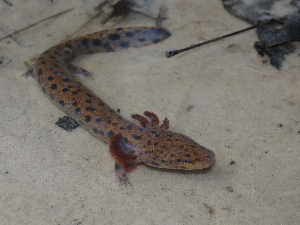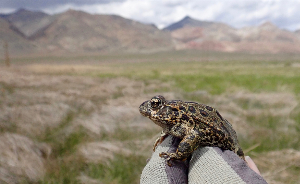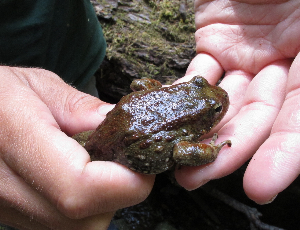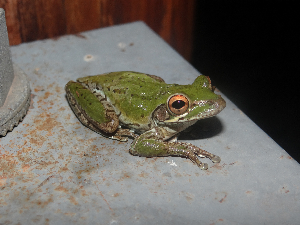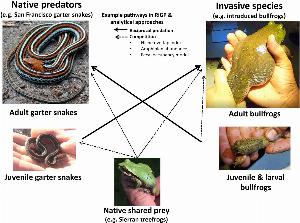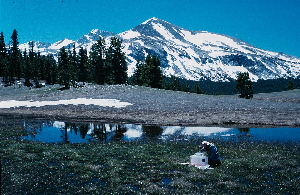Search ARMI Database
Search term(s)
Contribution Number
Search Results
877 record(s) found.
Papers & Reports Abundance of Gulf Coast Waterdogs (Necturus beyeri) along Bayou Lacombe, Saint Tammany Parish, Louisiana
Authors: Brad M Glorioso; Hardin J Waddle; L J Muse; S T Godfrey
Date: 2021-06-11 | Outlet: Journal of Herpetology
Few ecological studies have been conducted on Gulf Coast Waterdogs (Necturus beyeri), and published studies have focused on relatively small stream sections of 125 m to https://1.75 km. In 2015, we sampled Gulf Coast Waterdogs at 25 locations along a 13.4-km stretch of Bayou Lacombe (Saint Tammany Parish, Louisiana, USA) to better understand factors that may influence the distribution of Gulf Coast Waterdogs within streams. We checked 250 unbaited traps once per week for three weeks and captured 170 Gulf Coast Waterdogs at 18 of the 25 sites. We used hierarchical models of abundance to estimate abundance at each site as a function of site covariates including pH, turbidity, and distance from headwaters. The abundance of Gulf Coast Waterdogs within Bayou Lacombe was highest toward the center of the segment of stream we sampled, but we found no evidence that pH or turbidity affected abundance within our study area. Site level abundance estimates of Gulf Coast Waterdogs ranged from 0 to 82, and we estimated that there were 767 (95% Bayesian credible interval [CRI]: 266–983) Gulf Coast Waterdogs summed across all 25 sampling sites. We derived an estimate of 6,321 (95% CRI: 2,139–15,922) Gulf Coast Waterdogs for the entire 13.4 km section of Bayou Lacombe, which includes our 25 sites and the adjoining stream reaches between our sites. Our results suggest that Gulf Coast Waterdogs may be uncommon or absent in the headwaters, possibly because of shallow water and swift currents with little preferred habitats, and prefer the middle stream reaches with adequate depth and an abundance of preferred microhabitats.
Papers & Reports Enigmatic Near-Extinction in a Boreal Toad Metapopulation in Northwestern Montana
Authors: Rebecca M McCaffery; Robin E Russell; Blake R Hossack
Outlet: Journal of Wildlife Management
North America’s protected lands harbor significant biodiversity and provide habitats where species threatened by a variety of stressors in other environments can thrive. Yet disease, climate change, and other threats are not limited by land management boundaries and can interact with conditions within protected landscapes to affect sensitive populations. We examined the population dynamics of a boreal toad (Anaxyrus boreas) metapopulation at a wildlife refuge in northwestern Montana over a 16-year period (2003-2018). We used robust design capture-recapture models to estimate male population size, recruitment, and apparent survival over time and in relation to the amphibian chytrid fungus, Batrachochytrium dendrobatidis. We estimated female population size in years with sufficient captures. Finally, we examined trends in male and female toad body size and condition. We found no evidence of an effect of disease or time on male toad survival but detected a strong negative trend in recruitment of new males to the population. Estimates of male and female abundance decreased dramatically over time. Body size of males and females was inversely related to estimated population size, consistent with reduced recruitment to replace adults, but body condition of adult males was only weakly associated with abundance. Together, these results describe the demography of a near-extinction event, and point to dramatic decreases in the recruitment of new individuals to the breeding population as the cause of this decline. We surmise that processes related to the restoration of historical hydrology within the refuge adversely affected amphibian breeding habitat, and that these changes interacted with disease, life history, and other factors to restrict the recruitment of new individuals to the breeding population over time. Our results point to challenges in understanding and predicting drivers of population change and highlight that current metrics for assessing population status can have limited predictive ability.
Papers & Reports Why disease ecology needs life-history theory: a host perspective
Authors: Andrés Valenzuela-Sánchez; M Wilbur; Stefano Canessa; Leonardo Bacigalupe; Erin Muths; Benedikt R Schmidt; A C Cunningham; A Ozgul; P TJ Johnson; Hugo Cayuela
Date: 2020-12 | Outlet: Ecology Letters
When facing an emerging infectious disease of conservation concern, we often have little
information on the nature of the host-parasite interaction to inform management decisions.
However, it is becoming increasingly clear that the life-history strategies of host species
can be predictive of individual- and population-level responses to infectious disease, even
without detailed knowledge on the specifics of the host-parasite interaction. Here, we argue
that a deeper integration of life-history theory into disease ecology is timely and necessary
to improve our capacity to understand, predict, and mitigate the impact of endemic and
emerging infectious diseases in wild populations. Using wild vertebrates as an example, we
show that host life-history characteristics influence host responses to parasitism at different
levels of organization, from individuals to communities. We also highlight knowledge gaps
and future directions for the study of life-history and host responses to parasitism. We
conclude by illustrating how this theoretical insight can inform the monitoring and control
of infectious diseases in wildlife.
information on the nature of the host-parasite interaction to inform management decisions.
However, it is becoming increasingly clear that the life-history strategies of host species
can be predictive of individual- and population-level responses to infectious disease, even
without detailed knowledge on the specifics of the host-parasite interaction. Here, we argue
that a deeper integration of life-history theory into disease ecology is timely and necessary
to improve our capacity to understand, predict, and mitigate the impact of endemic and
emerging infectious diseases in wild populations. Using wild vertebrates as an example, we
show that host life-history characteristics influence host responses to parasitism at different
levels of organization, from individuals to communities. We also highlight knowledge gaps
and future directions for the study of life-history and host responses to parasitism. We
conclude by illustrating how this theoretical insight can inform the monitoring and control
of infectious diseases in wildlife.
Papers & Reports Monitoring wetland water quality related to livestock grazing in amphibian habitats
Authors: Kelly L Smalling
Date: 2021-01-13 | Outlet: Environmental Monitoring and Assessment 193, 58
Land use alteration such as livestock grazing can affect water quality in habitats of at-risk wildlife species. Data from managed wetlands are needed to understand levels of exposure for aquatic life stages and monitor grazing-related changes afield. We quantified spatial and temporal variation in water quality in wetlands occupied by threatened Oregon spotted frog (Rana pretiosa) at Klamath Marsh National Wildlife Refuge in Oregon, US. We used analyses for censored data to evaluate the importance of habitat type and grazing history in predicting concentrations of nutrients, turbidity, fecal indicator bacteria (FIB; total coliforms, E. coli, and enterococci), and estrogenicity, an indicator of estrogenic activity. Nutrients (orthophosphate and ammonia) and enterococci varied over time and space, while E. coli, total coliforms, turbidity, and estrogenicity were more strongly associated with local livestock grazing metrics. Turbidity was correlated with several grazing-related constituents and may be particularly useful for monitoring water quality in landscapes with livestock use. Concentrations of orthophosphate and estrogenicity were elevated at several sites relative to published health benchmarks, and their potential effects on R. pretiosa warrant further investigation. Our data provided an initial assessment of potential exposure of amphibians to grazing related constituents in western US wetlands.
Papers & Reports Density dependence and adult survival drive dynamics in two high elevation amphibian populations
Authors: Amanda M Kissel; S Tenan; Erin Muths
Date: 2020-12-12 | Outlet: Diversity 2020, 12, 478; doi:10.3390/d12120478
Amphibian conservation has progressed from the identification of declines to mitigation, but efforts are hampered by the lack of nuanced information about the effects of environmental characteristics and stressors on mechanistic processes of population regulation. Challenges include a paucity of long-term data and scant information about the relative roles of extrinsic (e.g., weather) and intrinsic (e.g., density dependence) factors. We used a Bayesian formulation of an open population capture-recapture model and >30 years of data to examine intrinsic and extrinsic factors regulating two adult boreal chorus frogs (Pseudacris maculata) populations. We modelled population growth rate and apparent survival directly, assessed their temporal variability, and derived estimates of recruitment. Populations were relatively stable (geometric mean population growth rate >1), and regulated by negative density dependence (i.e., higher population sizes reduced population growth rate). In the smaller population, density dependence also acted on adult survival. In the larger population, higher population growth was associated with warmer autumns. Survival estimates ranged from https://0.30-0.87, per-capita recruitment was <1 in most years, and mean seniority probability was >https://0.50, suggesting adult survival is more important to population growth than recruitment. Our analysis indicates density dependence is a primary driver of population dynamics for P. maculata adults.
Papers & Reports Water Temperature and Availability Shape the Spatial Ecology of a Hot Springs Endemic Toad (Anaxyrus williamsi)
Authors: Brian J Halstead; Patrick M Kleeman; Jonathan P Rose; Kristen J Fouts
Date: 2021-02-26 | Outlet: Herpetologica
Desert amphibians are limited to exploiting ephemeral resources and aestivating or to inhabiting scarce refuges of permanent water, such as springs. Understanding how amphibians use these resources is essential for their conservation. Dixie Valley Toads (Anaxyrus williamsi) are precinctive to a small system of cold and hot springs in the Dixie Valley, Nevada, USA. The toads have been petitioned for listing under the US Endangered Species Act, and information about how they use terrestrial and aquatic resources will help managers to conserve the toads and identify threats like geothermal energy development that might affect these toads. We used radiotelemetry to study the seasonal home ranges, movements, and habitat associations of Dixie Valley Toads in autumn 2018 and spring 2019. We found that toads were very closely associated with water in both seasons, with most observations occurring in water, especially for males in spring and all toads in the autumn. Even when found in terrestrial habitat, toads were a median distance of 4.2 m (95% credible interval = 3.3–5.3) from water; 95% of the time in spring and autumn, toads were within 14 m of water. Dixie Valley Toad habitat selection indicated a similar pattern, with selection in both spring and autumn for locations closer to water and for warmer water and substrates than at nearby available locations. In autumn, toads also avoided bare ground and terrestrial graminoids. Dixie Valley Toads selected brumation sites in, over (within dense vegetation), or near water, often near springs where water depths and temperatures are likely stable through the winter. The reliance of Dixie Valley Toads on water in spring, autumn, and during brumation suggests that alteration to historical flows and water temperatures are likely to affect the toads. Changes to the hydrothermal environment when toads are brumating could be particularly detrimental, potentially killing inactive toads.
Papers & Reports Estimating the survival of unobservable life stages for a declining frog with a complex life-history.
Authors: Jonathan P Rose; Sarah J Kupferberg; Clara A Wheeler; Patrick M Kleeman; Brian J Halstead
Date: 2021-02-15 | Outlet: Ecosphere 12(2):e03381
Demographic models enhance understanding of drivers of population growth and inform conservation efforts to prevent population declines and extinction. For species with complex life histories, however, parameterizing demographic models is challenging because some life stages can be dif?cult to study directly. Integrated population models (IPMs) empower researchers to estimate vital rates for organisms that have cryptic or widely dispersing early life stages by integrating multiple demographic data sources. For a stream-inhabiting frog(Rana boylii) that is declining through much of its range in Oregon and California, USA, we collected egg-mass counts and capture–mark–recapture data on adults from two populations in California to ?t IPMs that estimate adult abundance and the survival rate of both marked and unobserved life stages. Estimates of adult abundance based on long-term monitoring of egg-mass counts showed that study populations ?uctuated greatly inter-annually but were stable at longer timescales (i.e., decades). Adult female survival during 5–6 yr of capture–mark–recapture study periods was nearly equal in each population. Survival rate of R. boylii eggs to the subadult stage is low on average (0.002) but highly variable among years depending on post-oviposition stream ?ow. Population viability analysis showed that survival of adult and subadult life stages has the greatest proportional effect on population growth; the survival of egg and tadpole life stages, however, is more malleable by management interventions. For example, simulations showed head-starting of tadpoles, salvaging stranded egg masses, and limiting aseasonal pulsed ?ows could dramatically reduce the threat of extirpation. This study demonstrates the value of integrating multiple demographic data sources to construct models of population dynamics in species with complex life histories.
Papers & Reports Conservation genomics of the threatened western spadefoot, Spea hammondii, in urbanized southern California
Authors: K M Neal; Robert N Fisher; M J Mitrovich; H B Shaffer
Date: 2020-11-27 | Outlet: Journal of Heredity 2020:613-627
Populations of the western spadefoot (Spea hammondii) in southern California occur in one of the most urbanized and fragmented landscapes on the planet and have lost up to 80% of their native habitat. Orange County is one of the last strongholds for this pond-breeding amphibian in the region, and ongoing restoration efforts targeting S. hammondii have involved habitat protection and the construction of artificial breeding ponds. These efforts have successfully increased breeding activity, but genetic characterization of the populations, including estimates of effective population size and admixture between the gene pools of constructed artificial and natural ponds, has never been undertaken. Using thousands of genome-wide single-nucleotide polymorphisms, we characterized the population structure, genetic diversity, and genetic connectivity of spadefoots in Orange County to guide ongoing and future management efforts. We identified at least 2, and possibly 3 major genetic clusters, with additional substructure within clusters indicating that individual ponds are often genetically distinct. Estimates of landscape resistance suggest that ponds on either side of the Los Angeles Basin were likely interconnected historically, but intense urban development has rendered them essentially isolated, and the resulting risk of interruption to natural metapopulation dynamics appears to be high. Resistance surfaces show that the existing artificial ponds were well-placed and connected to natural populations by low-resistance corridors. Toad samples from all ponds (natural and artificial) returned extremely low estimates of effective population size, possibly due to a bottleneck caused by a recent multi-year drought. Management efforts should focus on maintaining gene flow among natural and artificial ponds by both assisted migration and construction of new ponds to bolster the existing pond network in the region.
Papers & Reports Accommodating the role of site memory in dynamic species distribution models using detection/non-detection data
Authors: Graziella V DiRenzo; A David; Blake R Hossack; Brent H Sigafus; P E Howell; Evan HC Grant; Erin Muths
Outlet: Ecology xx:xxx-xxx
First-order dynamic occupancy models (FODOMs) are a class of state-space model in which the true state (occurrence) is observed imperfectly. An important assumption of FODOMs is that site dynamics only depend on the current state and that variations in dynamic processes are adequately captured with covariates or random effects. However, it is often difficult to measure the covariates that generate ecological data, which are often spatio-temporally correlated. Consequently, the non-independent error structure of correlated data causes underestimation of parameter uncertainty and poor ecological inference. Here, we extend the FODOM framework with a second-order Markov process to accommodate site memory when covariates are not available. Our modeling framework can be used to make reliable inference about site occupancy, colonization, extinction, turnover, and detection probabilities. We present a series of simulations to illustrate the data requirements and model performance. We then applied our modeling framework to 13 years of data from an amphibian community in southern Arizona, USA and find that site memory helps describe dynamic processes for most species. Our approach represents a valuable advance in obtaining inference on population dynamics, especially as they relate to metapopulations.
Papers & Reports The influence of species life history and distribution characteristics on species responses to habitat fragmentation in an urban landscape
Authors: Staci M Amburgey; David AW Miller; Carlton J Rochester; Katy S Delaney; Seth PD Riley; Cheryl S Brehme; Stacie A Hathaway; Robert N Fisher
Date: 2021-01-20 | Outlet: Journal of Animal Ecology
1. Fragmentation within urbanized environments often leads to a loss of native species diversity; however, variation exists in responses among-species and among-populations within species.
2. We aimed to identify patterns in species biogeography in an urbanized landscape to understand anthropogenic effects on vertebrate communities and identify species that are more sensitive or resilient to landscape change.
3. We investigated patterns in species richness and species responses to fragmentation in southern Californian small vertebrate communities using multispecies occupancy models and determined factors associated with overall commonness and sensitivity to patch size for 45 small vertebrate species both among and within remaining non-developed patches.
4. In general, smaller patches had fewer species, with amphibian species richness being particularly sensitive to patch size effects. Mammals were generally more common, occurring both in a greater proportion of patches and a higher proportion of the sites within occupied patches. Alternatively, amphibians were generally restricted to larger patches but were more ubiquitous within smaller patches when occupied. Species range size was positively correlated with how common a species was across and within patches, even when controlling for only patches that fell within a species’ range. We found sensitivity to patch size was greater for more fecund species and depended on where the patch occurred within a species’ range. While all taxa were more likely to occur in patches in the warmer portions of their ranges, amphibians and mammals were more sensitive to fragmentation in these warmer areas as compared to the rest of their ranges. Similarly, amphibians occurred at a smaller proportion of sites within patches in drier portions of their ranges. Mammals occurred at a higher proportion of sites that were also in drier portions of their range while reptiles did not differ in their sensitivity to patch size by range position.
5. We demonstrate that taxonomy, life history, range size, and range position can predict commonness and sensitivity of species across this highly fragmented yet biodiverse landscape. The impacts of fragmentation on species communities within an urban landscape depend on scale, with differences emerging among and within species and populations.
2. We aimed to identify patterns in species biogeography in an urbanized landscape to understand anthropogenic effects on vertebrate communities and identify species that are more sensitive or resilient to landscape change.
3. We investigated patterns in species richness and species responses to fragmentation in southern Californian small vertebrate communities using multispecies occupancy models and determined factors associated with overall commonness and sensitivity to patch size for 45 small vertebrate species both among and within remaining non-developed patches.
4. In general, smaller patches had fewer species, with amphibian species richness being particularly sensitive to patch size effects. Mammals were generally more common, occurring both in a greater proportion of patches and a higher proportion of the sites within occupied patches. Alternatively, amphibians were generally restricted to larger patches but were more ubiquitous within smaller patches when occupied. Species range size was positively correlated with how common a species was across and within patches, even when controlling for only patches that fell within a species’ range. We found sensitivity to patch size was greater for more fecund species and depended on where the patch occurred within a species’ range. While all taxa were more likely to occur in patches in the warmer portions of their ranges, amphibians and mammals were more sensitive to fragmentation in these warmer areas as compared to the rest of their ranges. Similarly, amphibians occurred at a smaller proportion of sites within patches in drier portions of their ranges. Mammals occurred at a higher proportion of sites that were also in drier portions of their range while reptiles did not differ in their sensitivity to patch size by range position.
5. We demonstrate that taxonomy, life history, range size, and range position can predict commonness and sensitivity of species across this highly fragmented yet biodiverse landscape. The impacts of fragmentation on species communities within an urban landscape depend on scale, with differences emerging among and within species and populations.
Papers & Reports Experimental evaluation of spatial capture-recapture study design
Authors: Jill Fleming; Evan HC Grant; S C Sterrett; C Sutherland
Date: 2021-07-18 | Outlet: Ecological Applications
A principal challenge impeding strong inference in analyses of wild populations is the lack of robust and long-term data sets. Recent advancements in analytical tools used in wildlife science may increase our ability to integrate smaller data sets and enhance the statistical power of population estimates. One such advancement, the development of spatial capture-recapture (SCR) methods, explicitly accounts for differences in spatial study designs, making it possible to equate multiple study designs in one analysis. SCR has been shown to be robust to variation in design as long as minimal sampling guidance is adhered to. However, these expectations are based on simulation and have yet to be evaluated in wild populations. Here we conduct a rigorously designed field experiment by manipulating the arrangement of artificial cover objects (ACOs) used to collect data on red-backed salamanders (Plethodon cinereus) to empirically evaluate the effects of design configuration on inference made using SCR. Our results suggest that, using SCR, estimates of space use and detectability are sensitive to study design configuration, namely the spacing and extent of the array, and that caution is warranted when assigning biological interpretation to these parameters. However, estimates of population density remain robust to design except when the configuration of detectors grossly violates existing recommendations.
Papers & Reports The Coyote Mountains’ Desert Snail (Sonorelix harperi carrizoensis), a Lazarus Species with the First Documentation of Live Individuals
Authors: Robert N Fisher; S R Fisher
Date: 2020-08 | Outlet: Bulletin Southern California Academy of Sciences 119:49-54.
The Coyote Mountain desert snail (Sonorelix harperi carrizoensis) was described in 1937 from 30 dry shells collected the previous year. We reviewed the literature and museum records and found two additional shell collections for this subspecies from the type locality one from 1958, and one from an adjacent mountain range in 1938. There is no evidence previously of any live snails being collected from the Coyote Mountains, Imperial County, California. All shell collections of S. harperi carrizoensis have the same locality data as the type series, which is Painted Gorge, Coyote Mountains except for one recorded collection of shells from the Vallecito Mountains from 1938. Using geological maps and other data sources, a potential mesic habitat was identified in the Coyote Mountains. During recent field work for salamanders at this location we detected two live specimens of S. harperi carrizoensis approximately 2 km north of its type location. This new data confirms this subspecies is still extant and has occurred at least at two sites historically in these mountains. Despite the presence of mesic habitats (i.e., mosses, liverworts and ferns) at the type locality, we found no evidence of S. harperi carrizoensis or salamanders.
Papers & Reports Baseline Conditions and Projected Future Hydro-Climatic Change in National Parks in the Conterminous United States
Authors: William A Battaglin
Date: 2020-06-15 | Outlet: Water 2020, 12(6), 1704; https://doi.org/10.3390/w12061704
Abstract: The National Park Service (NPS) manages hundreds of parks in the United States, and many contain important aquatic ecosystems and/or threatened and endangered aquatic species vulnerable to hydro-climatic change. More effective management of park resources under future hydro-climatic uncertainty requires information on both baseline conditions and the range of projected future conditions. A monthly water balance model was used to assess baseline (1981–1999) conditions and a range of projected future hydro-climatic conditions in 374 NPS parks. General circulation model outputs representing 214 future climate simulations were used to drive the model. Projected future changes in air temperature (T), precipitation (p), and runoff (R) are expressed as departures from historical baselines. Climate simulations indicate increasing T by 2030 for all parks with 50th percentile simulations projecting increases of https://1.67 °C or more in 50% of parks. Departures in 2030 p indicate a mix of mostly increases and some decreases, with 50th percentile simulations projecting increases in p in more than 70% of parks. Departures in R for 2030 are mostly decreases, with the 50th percentile simulations projecting decreases in R in more than 50% of parks in all seasons except winter. Hence, in many NPS parks, R is projected to decrease even when p is projected to increase because of increasing T in all parks. Projected changes in future hydro-climatic conditions can also be assessed for individual parks, and Rocky Mountain National Park and Congaree National Park are used as examples.
Papers & Reports Widespread Ranavirus and Perkinsea infections in Cuban Treefrogs (Osteopilus septentrionalis) invading New Orleans, USA
Authors: N Galt; Matthew S Atkinson; Brad M Glorioso; Hardin J Waddle; M Litton; Anna E Savage
Date: 2021-04-30 | Outlet: Herpetological Conservation and Biology
Papers & Reports Rapid assessment indicates context-dependent mitigation for amphibian disease risk
Authors: Riley F Bernard
Date: 2021-07-06 | Outlet: Wildlife Society Bulletin
Batrachochytrium salamandrovorans (Bsal) is a fungal pathogen that can cause the emerging infectious disease Bsal chytridiomycosis in some amphibians, and is currently causing dramatic declines in European urodeles. To date, Bsal has not been detected in North America but has the potential to cause severe declines in naïve hosts if introduced. Therefore, it is critical that wildlife managers are prepared with effective management actions to combat the fungus. Research has been initiated to identify strategies; however, managers need guidance to prepare for an outbreak until results are available. Here, we conducted a workshop with participants of a Bsal symposium to describe the expected effect of eleven management actions that could be implemented for Bsal in three salamander communities in the northwestern, northeastern, and southeastern United States. Participants expected variation in the proposed management actions to decrease pathogen transmission and increase host survival, but also expected that the selection of a management action may depend on the specific membership of the amphibian community. Collectively, this assessment will help refine research and modeling priorities in an effort to mitigate the risk of Bsal to native U.S. amphibians.
Papers & Reports Principles and mechanisms of wildlife population persistence in the face of disease
Authors: Robin E Russell; Graziella V DiRenzo; Katrina E Alger; J Szymanski; Evan HC Grant
Outlet: Frontiers in Ecology and Evolution
Emerging infectious diseases can result in species declines and hamper recovery efforts for at-risk populations. Generalizing considerations for reducing the risk of pathogen introduction and mitigating the effects of disease remains challenging and inhibits our ability to provide guidance for species recovery planning. Given the growing rates of emerging pathogens globally, we identify key principles and mechanisms for maintaining sustainable populations in the face of emerging diseases (including minimizing the risk of pathogen introductions and their future effects on hosts). Our synthesis serves as a reference for minimizing the risk of future disease outbreaks, mitigating the deleterious effects of future disease outbreaks on species extinction risk, and a review of the theoretical and/or empirical examples supporting these considerations.
Papers & Reports A latent process model approach for improving the utility of indicator species
Authors: Jill Fleming; C Sutherland; S Sterrett; Evan HC Grant
Outlet: Oikos
The state of an ecosystem is governed by dynamic biotic and abiotic processes, which can only be partially observed. Costs associated with measuring each component limit the feasibility of comprehensive assessments of target ecosystems. Instead, indicator species are recommended as a surrogate index. While this is an attractive concept, indicator species have rarely proven to be an effective tool for monitoring ecosystems and informing management decisions. One deficiency in the existing theoretical development of indicator species may be overcome with the incorporation of latent (i.e., unobservable) states. Advancements in quantitative ecological models allow for latent-state models to be tested empirically, facilitating the robust evaluation and practical use of indicator species for ecosystem science and management. Here, we extend the existing conceptual models of indicator species to include a direct relationship between an indicator species, ecosystem change drivers, and latent processes and variables. Our approach includes explicit consideration of important estimation uncertainty and narrows the range of values a latent variable may take by relating it to measurable attribute(s) of an indicator species. We demonstrate the utility of this approach by relating a commonly cited indicator species, the red-backed salamander (Plethodon cinereus), to a typical latent process of interest – ecosystem health.
Papers & Reports When Introduced Prey Violates Trophic Hierarchy: Conservation of an Endangered Predator
Authors: Richard Kim; Brian J Halstead; E Routman; Julie Andersen
Date: 2021-03-03 | Outlet: Biological Conservation 256
Introduced species often disrupt established food webs, but some native predators can come to rely on introduced prey. Understanding the net effects of the non-natives on imperiled predators is crucial for planning conservation measures. The invasive American bullfrog (Lithobates catesbeianus) can be prey, predator, and competitor for the critically endangered San Francisco garter snake (Thamnophis sirtalis tetrataenia). We examined the seasonal prey use of a San Francisco garter snake population that co-occurs with American bullfrogs to examine intraguild predation between these species. Juvenile and adult snakes mainly consumed native anurans instead of American bullfrogs, and this diet pattern peaked in spring, a critical foraging period for the snakes. In spring, large adult American bullfrogs also foraged heavily on native anurans and displayed a high degree of diet overlap with San Francisco garter snakes. Invasive American bullfrogs are detrimental to San Francisco garter snakes mainly through seasonal competition rather than reciprocal predation. Removal of invasive species provided further evidence that eliminating American bullfrogs can benefit San Francisco garter snakes by reducing predation pressure on their shared amphibian prey. Better understanding the interactions of invasive species with native species of conservation concern informs management practices and improves conservation outcomes.
Papers & Reports Effects of experimental warming and nutrient enrichment on wetland communities at the Arctic’s edge
Authors: J M Davenport; L Fishback; Blake R Hossack
Date: 2020-09 | Outlet: Hydrobiologia
The disproportionate effects of warming for high-latitude, freshwater ecosystems has been well documented, but in some areas, changes have been further impacted by human-subsidized increases of waterfowl. To gain insight into how predicted changes in temperature and nutrient inputs might affect ecosystem function, we conducted a mesocosm experiment in the Canadian Subarctic with three levels of simulated goose enrichment and warming to measure changes in size and survival of larval wood frogs and boreal chorus frogs and primary productivity (phytoplankton and periphyton biomass). Our results highlight that the consequences of these rapid changes are non-linear and even non-intuitive, with species-specific consumer and ecosystem responses that depend on the magnitude of temperature and nutrient changes as well as community composition.
Papers & Reports Climate’s cascading effects on disease, predation, and hatching success in Anaxyrus canorus, the threatened Yosemite toad
Authors: Walt J Sadinski; A L Gallant; J Cleaver
Date: 2020-09-01 | Outlet: Global Ecology and Conservation
The U.S. Fish and Wildlife Service listed Anaxyrus canorus, the Yosemite toad, as federally threatened in 2014 based upon reported population declines and vulnerability to global-change factors. A. canorus lives only in California’s central Sierra Nevada at medium to sub-alpine elevations. Lands throughout its range are protected from development, but climate and other global-change factors potentially can limit populations. A. canorus reproduces in ultra-shallow wetlands that typically hydrate seasonally via melting of the winter snowpack. Lesser snowpacks in drier years can render wetland water volumes and hydroperiods insufficient to allow for successful breeding and reproduction. Additionally, breeding and embryogenesis occur very soon after wetlands thaw when overnight temperatures can be below freezing. Diseases, such as chytridiomycosis, which recently decimated regional populations of ranid species, also might cause declines of A. canorus populations. However, reported studies focused on whether climate interacts with any pathogens to affect fitness in A. canorus have been scarce. We investigated effects of these factors on A. canorus near Tioga Pass from 1996 to 2001. We found breeding subpopulations were distributed widely but inconsistently among potentially suitable wetlands and frequently consisted of small numbers of adults. We occasionally observed small but not alarming numbers of dead adults at breeding sites. In contrast, embryo mortality often was notably high, with the majority of embryos dead in some egg masses while mortality among coincidental Pseudacris regilla (Pacific treefrog) embryos in deeper water was lower. After sampling and experimentation, we concluded that freezing killed A. canorus embryos, especially near the tops of egg masses, which enabled Saprolegnia diclina (a water mold [Oomycota]) to infect and then spread through egg masses and kill more embryos, often in conjunction with predatory flatworms (Turbellaria spp.). We also concluded exposure to ultraviolet-B radiation did not play a role. Based upon our assessments of daily minimum temperatures recorded around snow-off during years before and after our field study, the freezing potential we observed at field sites during embryogenesis might have been commonplace beyond the years of our field study. However, interactions among snow quantity, the timing of snow-off, and coincidental air temperatures that determine such freezing potential make projections of future conditions highly uncertain, despite overall warming trends. Our results describe important effects from ongoing threats to the fitness and abundance of A. canorus via reduced reproduction success and demonstrate how climate conditions can exacerbate effects from pathogens to threaten the persistence of amphibian populations.

